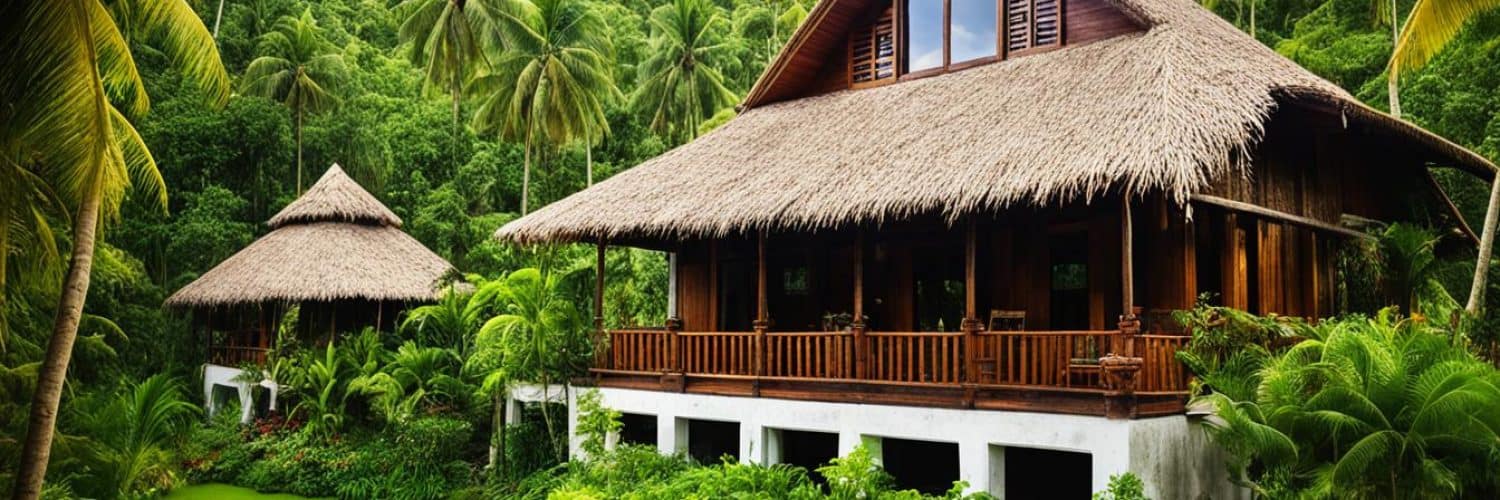Have you ever wondered what an ancestral home built in the mid-1800s looks like? Step into the Cang-isok House in Siquijor, Philippines, and travel back in time to experience traditional Filipino architecture and witness a historical landmark. This century-old house, made from indigenous materials, proudly stands as an ancestral home and a cultural heritage site.
As you enter the Cang-isok House, you’ll be captivated by its unique design, constructed using bamboo, nipa sheets, and hardwood. Surrounded by the tranquil beauty of Brgy. Libo’s shores and elevated on stilts, the house showcases the remarkable resilience of traditional Filipino architecture.
But what is the story behind the Cang-isok House? How has it endured the test of time and various natural calamities? Join us as we delve into the history, design, and significance of this must-visit destination in Siquijor, Philippines.
Key Takeaways:
- The Cang-isok House is a century-old ancestral home in Siquijor, Philippines, built in the mid-1800s.
- It features traditional Filipino architecture and is made from bamboo, nipa sheets, and hardwood.
- The Cang-isok House stands on stilts on the shore of Brgy. Libo, showcasing its historical significance and cultural heritage.
- Despite its weathered appearance, the house has withstood the test of time and various natural calamities.
- Explore the unique charm and significance of the oldest surviving house in Siquijor, a cultural heritage site not to be missed.
History of the Cang-isok House
The Cang-isok House, also known as the Tejano House, holds a rich historical significance in Siquijor. Built in the mid-1800s by Mariano Tejano, a Spanish resident, this ancestral house stands as a testament to the island’s history and cultural heritage.
“The Cang-isok House is a true historical gem, reflecting the passing of time and the events that shaped Siquijor. It serves as a link to the Spanish colonial era and the post-war ancestral homes that were once prevalent on the island.”
Despite the passage of time, the Cang-isok House remains as the oldest known surviving house in Siquijor, surviving natural calamities and various historical events. Many other Spanish and post-war ancestral houses have vanished over the years, making the Cang-isok House a rare historical structure that provides valuable insights into the island’s past.
The Tejano House, with its well-preserved architecture and design, showcases the influence of Spanish colonizers during that period. It stands as a tangible reminder of the island’s history and serves as a bridge to a bygone era.
| Historical Significance | Architectural Style | Surviving Ancestral Houses |
|---|---|---|
| The Cang-isok House is a historical structure that reflects the cultural heritage of Siquijor. | The architectural design of the house showcases the influence of Spanish colonizers. | Many Spanish and post-war ancestral houses no longer exist in Siquijor, making the Cang-isok House a rare surviving example. |
The Cang-isok House remains a significant piece of Siquijor’s history, highlighting its heritage and cultural identity. Its existence serves as a reminder of the island’s past and the architectural styles that once dominated the region. Preserving and appreciating this historical gem is vital to ensure future generations can appreciate the rich history and cultural legacy of Siquijor.
Design and Architecture of the Cang-isok House
The Cang-isok House showcases a unique and traditional architectural design that reflects the rich cultural heritage of the Philippines. This section will delve into the exquisite features of the house, such as its use of stilts, local hardwoods, and a nipa roof.
One of the distinctive elements of the Cang-isok House is its construction on stilts. By elevating the house above the ground, it is protected from wild animals and changing tides, ensuring its longevity. This design feature not only serves a practical purpose but also adds to the overall charm of the house.
The construction of the Cang-isok House primarily utilizes local hardwoods like tugas and molave. These indigenous materials lend strength and durability to the structure while showcasing the natural beauty of the Philippines. The use of local hardwoods not only enhances the authenticity of the house but also supports sustainable practices.
The roof of the Cang-isok House is made of nipa, a traditional roofing material in the Philippines. Nipa roofs are known for their water-resistant properties and natural insulation, keeping the interior of the house cool and comfortable. This traditional roofing material adds a touch of cultural authenticity to the house, further immersing visitors in the local heritage.
“The Cang-isok House stands as a testament to the traditional Filipino architecture of the time. Its design and use of indigenous materials showcase the ingenuity and resourcefulness of our ancestors.”
The Cang-isok House has undergone some renovations over the years, yet it has managed to retain its original design and materials. This commitment to preserving the cultural and historical integrity of the house allows visitors to experience the traditional Filipino architecture in its authentic form.
Features of the Cang-isok House
| Design Element | Description |
|---|---|
| Stilts | The house is elevated on stilts, providing protection from wild animals and changing tides. |
| Local Hardwoods | Tugas and molave, indigenous hardwoods, are used in the construction, ensuring strength and durability. |
| Nipa Roof | The roof is made of nipa, a traditional Filipino roofing material known for its water-resistant and insulating properties. |
Current Status and Preservation Efforts
Unfortunately, the Cang-isok House in Siquijor is currently in a neglected state. Despite its historical significance and cultural heritage, preservation efforts have been lacking. The local government has expressed its desire to protect this iconic landmark, but there has been a noticeable lack of effort in maintaining and conserving the house.
Many tourists who visit the Cang-isok House express disappointment at the deteriorated condition of the structure. The neglect is evident in the weathered appearance of the house and the lack of proper maintenance and restoration. It is disheartening to see such an important historical site fall into neglect.
Preserving cultural heritage sites is crucial in maintaining the rich history and identity of a place. The Cang-isok House is not only a symbol of traditional Filipino architecture but also serves as a window into the past, showcasing the resilience of the local community. It is imperative that the local government and relevant authorities recognize the urgent need for preservation and take immediate action to ensure the long-term survival of this historical landmark.
“Preservation of our cultural heritage is not only a duty of the local government but also a responsibility shared by the community. It is a testament to our roots and a valuable resource for future generations.”
In order to address this neglect, it is vital for the local government to collaborate with heritage conservation organizations, tourism stakeholders, and the owners of the Cang-isok House. The establishment of a comprehensive preservation plan, including regular maintenance, restoration efforts, and stringent guidelines for visitors, can help revive and protect this iconic structure.
Efforts can include the documentation of the house’s history, the implementation of structural repairs, and the establishment of visitor management protocols. By raising awareness about the importance of preserving historical landmarks like the Cang-isok House, the local government can engage the community and garner support for ensuring its future survival.
Preservation Efforts at Other Historical Sites
Several historical landmarks around the world have successfully undergone preservation efforts, setting a precedent for the restoration and conservation of the Cang-isok House. The Taj Mahal in India, the Great Wall of China, and the Acropolis of Athens in Greece are just a few examples of cultural heritage sites that have been meticulously conserved to ensure their longevity.
Through effective preservation strategies and a concerted effort, these landmarks have been protected and have continued to attract tourists from all over the world. Learning from these successful endeavors in heritage preservation can provide valuable insights and inspire action to save the Cang-isok House from further neglect.
Ways to Support Preservation Efforts
As concerned individuals, there are several ways to contribute to the preservation of the Cang-isok House and other cultural heritage sites:
- Support local initiatives: Stay informed about local conservation efforts and contribute to organizations working towards the preservation of historical landmarks.
- Spread awareness: Share information about the Cang-isok House and its historical importance with friends, family, and online communities through social media and other platforms.
- Visit responsibly: When visiting the Cang-isok House, follow any rules or guidelines in place to protect the structure and ensure its preservation for future generations.
- Advocate for change: Write to local government representatives and express your concerns about the neglected state of the Cang-isok House. Encourage them to prioritize heritage preservation efforts.
By actively participating in the preservation efforts, we can collectively make a difference and safeguard the historical and cultural treasures of Siquijor, including the Cang-isok House.
Location of the Cang-isok House
The Cang-isok House is nestled in the charming Barangay Libo of Enrique Villanueva, Siquijor. Situated alongside the breathtaking coastline, this historical landmark offers a truly picturesque setting for visitors to immerse themselves in the beauty of the region. Accessing this cultural gem is convenient, as it can be reached easily from the well-known Siquijor Circumferential Road. However, be prepared to navigate a few steps, as the house is located below the level of the highway, adding a touch of adventure to the journey.
With its prime location in Barangay Libo, visitors to the Cang-isok House can indulge in the captivating view of the coastline while exploring the rich cultural heritage of the area. The tranquil atmosphere, gentle ocean waves, and enchanting surroundings are sure to create a memorable experience.
Cang-isok House as a Tourist Attraction
The Cang-isok House is a popular house in Siquijor, making it one of the top tourist spots on the island. Visitors from all over are drawn to this historical and cultural gem, which is often included in countryside tour packages. Whether you’re interested in the history or architecture of the Philippines, a visit to the Cang-isok House is an absolute must-do activity during your time in Siquijor.
The Cang-isok House offers a unique glimpse into traditional Filipino architecture and serves as a testament to the island’s rich cultural heritage. Its rustic charm and picturesque surroundings make it a captivating destination for tourists. Exploring the house provides a deeper understanding of the historical significance it holds and allows you to appreciate the enduring beauty of this popular house in Siquijor.
Charm and Significance of the Cang-isok House
The Cang-isok House holds great charm and significance as the oldest surviving house in Siquijor. It represents the traditional Filipino native house, with its humble yet beautiful design. Despite its weathered appearance, the house exudes strength, character, and resilience against the test of time. It serves as a reminder of the rich cultural history of the province.
Steeped in history, the Cang-isok House stands as a testament to the traditional Filipino architecture and the enduring spirit of its people. With its simple yet elegant structure, the house showcases the craftsmanship of the past and the cultural heritage it encompasses. As the oldest surviving house in Siquijor, it stands as a living legacy, preserving the customs and traditions of the Filipino people.
“The Cang-isok House is not simply a dilapidated structure; it is a glimpse into the lives of our ancestors, a tangible connection to our past.” – Anonymous
The charm of the Cang-isok House lies in its authentic representation of a traditional Filipino native house. The use of indigenous materials like bamboo, nipa sheets, and local hardwoods reflects the resourcefulness and ingenuity of the Filipino people. Each imperfection and weathered surface tells a story, evoking a sense of nostalgia and admiration for the craftsmanship of bygone eras.
The Significance of Heritage Preservation
Preserving the Cang-isok House is not just about maintaining a historical structure; it is a means of honoring the collective memory and cultural identity of the Filipino people. The house serves as a tangible link to the past, allowing future generations to connect with their roots and understand the evolution of traditional Filipino architecture.
| Oldest Surviving House | Traditional Filipino Native House |
|---|---|
| Constructed in the mid-1800s | Built with indigenous materials |
| Stands as a historical landmark | Represents the cultural heritage of the province |
| Withstands the test of time | Exudes charm and resilience |
By upholding the historical significance of the Cang-isok House, we pay tribute to the generations that came before us and ensure that their stories and traditions are not forgotten. It is through the preservation of sites like this that we can truly appreciate the richness and diversity of our cultural heritage.
The Enchanting Surroundings of the Cang-isok House
The Cang-isok House is a hidden gem, nestled amidst the enchanting beauty of nature. Its serene location offers visitors a tranquil retreat, surrounded by breathtaking views of blue waters and gentle waves. The picturesque surroundings create a relaxing atmosphere, perfect for immersing oneself in the historical and cultural significance of this remarkable landmark.
As you step into the Cang-isok House, you’ll be captivated by the idyllic setting that greets you. The soothing sound of the waves and the gentle breeze create a sense of calm, transporting you to a world of tranquility. Whether you’re exploring the house’s architectural marvels or simply taking in the scenic beauty, the enchanting surroundings add an extra layer of charm to your experience.
The image above showcases the mesmerizing blue waters and gentle waves that surround the Cang-isok House. This captivating view serves as a backdrop to the historical landmark, enhancing its allure and providing a visual feast for visitors.
Imagine sitting on the veranda of the Cang-isok House, overlooking the stunning panorama of the ocean. The rhythmic motion of the waves and the soft murmur of the water create a sense of tranquility, inviting you to unwind and immerse yourself in the moment. It’s the perfect place to reflect, rejuvenate, and find solace in the beauty of nature.
“The enchanting surroundings of the Cang-isok House make it a truly unique destination. The combination of blue waters, gentle waves, and a relaxing atmosphere transport visitors to a world of serenity and peace.” – Traveler’s Review
Whether you’re a history enthusiast, an architecture lover, or simply seeking a serene escape, the Cang-isok House and its enchanting surroundings offer an unforgettable experience. Take a moment to soak in the beauty of nature, and let the tranquility wash over you as you explore the rich cultural heritage of this remarkable destination.
The Unique Name of Cang-isok House
The origin of the name “Cang-isok” remains a mystery. It could be derived from the name of the barrio or have a deeper meaning associated with its history or ownership. The exact meaning and significance of the name have yet to be fully understood, adding to the intrigue and allure of the Cang-isok House.
The Future of the Cang-isok House
The future of the Cang-isok House relies on heritage preservation efforts and collaboration between local tourism stakeholders and the owners. It is crucial to recognize the historical and cultural significance of this ancestral home and take steps to ensure its long-term preservation.
While there may be a temptation to restore and renovate the house, it is essential to consider the unique value that its battered appearance brings. The current condition of the Cang-isok House serves as a tangible testament to its enduring history, defying the odds and surviving through the years.
Preserving the house in its original, weathered state allows visitors to witness the passage of time and appreciate the resilience of this architectural masterpiece. It serves as a living record of the traditional Filipino architecture and cultural heritage of Siquijor.
Collaboration between local tourism stakeholders and the owners is key to ensuring the successful preservation of the Cang-isok House. By fostering partnerships and engaging in sustainable practices, they can work together to protect this precious piece of history for future generations to appreciate and learn from.
The historic Cang-isok House, showcasing the need for heritage preservation.
Exploring Siquijor’s Attractions
Aside from the Cang-isok House, Siquijor offers a variety of tourist destinations that are sure to captivate visitors. Whether you’re looking for pristine white sand beaches or breathtaking countryside landscapes, this enchanting island has something for everyone. Take a countryside tour to immerse yourself in the natural wonders and cultural heritage sites, or simply relax and unwind at a picturesque white beach resort like Salagdoong.
Here are some of the top attractions that Siquijor has to offer:
1. Salagdoong
Located on the eastern coast of Siquijor, Salagdoong is a popular white beach resort known for its crystal-clear waters and pristine sandy shores. It’s the perfect spot to indulge in water activities such as swimming, snorkeling, and diving. Don’t miss a chance to experience the exhilarating cliff diving at Salagdoong’s famous diving platforms.
2. Countryside Tour
“The countryside tour in Siquijor is a feast for the senses. From lush rice terraces and cascading waterfalls to centuries-old churches and enchanting caves, this tour showcases the island’s natural beauty and cultural heritage.” – Local Tour Guide
Embark on a countryside tour to explore the hidden gems of Siquijor. Witness the majestic beauty of the Cambugahay Falls with its cascading tiers of turquoise water. Marvel at the ancient balete tree and take a dip in its refreshing natural spring. Immerse yourself in the tranquil ambiance of century-old churches, such as the St. Isidore Church in Lazi and St. Francis of Assisi Parish Church in Siquijor town. The countryside tour promises a memorable journey through the heart and soul of Siquijor.
3. Mystic Island Art Cafe
Indulge your senses at the Mystic Island Art Cafe, a charming cafe and art gallery nestled in a lush garden setting. Enjoy a cup of local coffee while immersing yourself in the vibrant local art scene. The cafe also offers delectable homemade pastries and refreshing beverages, allowing you to relax and savor the island’s unique atmosphere.
| Attraction | Location | Highlight |
|---|---|---|
| Salagdoong | Eastern coast of Siquijor | White beach resort with cliff diving platforms |
| Countryside Tour | Various locations across Siquijor | Rice terraces, waterfalls, ancient churches |
| Mystic Island Art Cafe | San Juan, Siquijor | Cafe and art gallery in a garden setting |
Whether you choose to explore the stunning white beach resort of Salagdoong, embark on a countryside tour, or immerse yourself in the vibrant art scene at the Mystic Island Art Cafe, Siquijor promises a memorable and enchanting experience. Don’t miss out on the opportunity to discover the hidden treasures that this mystical island has to offer.
Discover the Mystical Island of Siquijor
Known as the “Island of Fire,” Siquijor captivates visitors with its majestic and enchanting beauty. Exploring the island reveals a tropical paradise filled with natural wonders, century-old churches, and cultural heritage sites. Whether it’s for a relaxing beach vacation or an adventure exploring the island’s mystical charm, Siquijor promises an unforgettable experience.
| Attractions | Description |
|---|---|
| Natural Wonders | Discover breathtaking waterfalls, lush forests, and stunning coastal landscapes that showcase the island’s natural beauty. |
| Century-Old Churches | Visit the historic churches of Siquijor, such as the St. Francis de Assisi Church, known for its well-preserved Spanish colonial architecture. |
| Cultural Heritage Sites | Immerse yourself in the island’s rich history and culture by exploring ancestral homes, museums, and traditional craft workshops. |
| Beach Escapes | Indulge in the sun, sand, and clear blue waters of Siquijor’s idyllic beaches, such as Salagdoong Beach and Paliton Beach. |
| Mystical Charm | Experience the island’s mystical side by visiting traditional healers, taking part in healing rituals, and witnessing mystical festivals. |
With its serene ambiance, welcoming locals, and vibrant cultural scene, Siquijor is a destination that promises to leave a lasting impression on every traveler. Whether you seek relaxation, adventure, or a deeper connection with nature and spirituality, this Island of Fire is a tropical paradise that will fulfill your wanderlust.
Conclusion
The Cang-isok House in Siquijor, Philippines, is not just a historical landmark but also a cultural heritage that showcases the traditional Filipino architecture. This century-old ancestral home stands as a testament to the rich history of the province. Made from indigenous materials like bamboo, nipa sheets, and hardwood, the house exudes the charm of traditional Filipino design.
Despite weathering various natural calamities, the Cang-isok House has remained resilient, defying the test of time. However, its current neglected state highlights the need for preservation efforts from the local government and tourism stakeholders. Recognizing the significance of cultural heritage sites like the Cang-isok House is crucial to preserving the history and cultural identity of the Philippines.
Visiting the Cang-isok House allows travelers to immerse themselves in the beauty and historical significance of Siquijor. As they explore the enchanting surroundings, including the picturesque coastline, they can appreciate the uniqueness of this cultural heritage site. Discover the charm of the Cang-isok House and witness the rich heritage left behind by our ancestors.


















Add comment